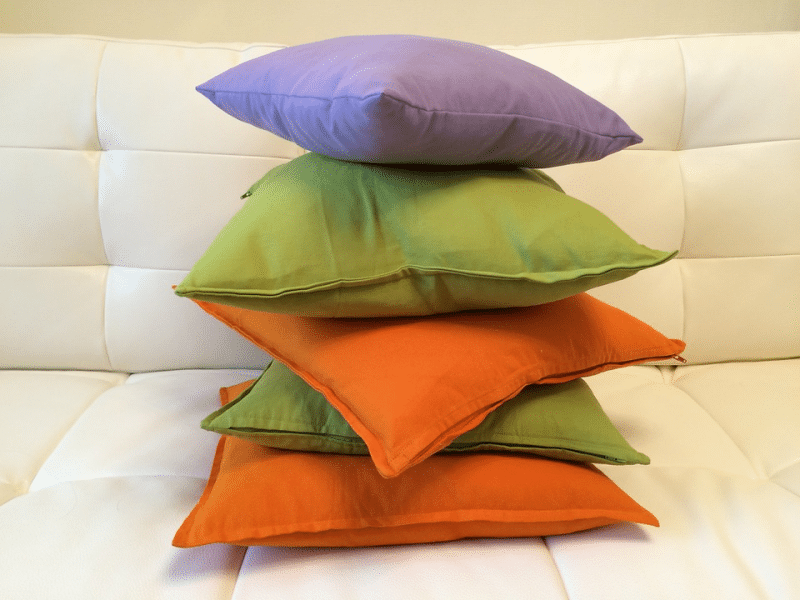If you want to know how much stuffing for a pillow you will need, it will depend on the pillow size and type of stuffing. Remember that you can use various materials to stuff a pillow, and their recommended amounts will also vary. You also want to consider the pillow structure you want to achieve, including its firmness and loft.
It’s essential to be familiar with different pillow fillings and their recommended amounts for every pillow size. This way, you’ll end up with a comfortable yet supportive pillow. Continue reading below to know what to expect for every stuffing type.

How Much Stuffing Do You Need For A Pillow?
Polyester
The polyester fiberfill you need for a pillow can be up to one pound if the pillow is standard. You can then adjust the amount based on the pillow size and your ideal loft and firmness. Remember that the pillow stuffing will dictate how supportive your pillow will be.
Shredded memory foam
If you don’t like polyester and prefer something more conforming and long-lasting, you can use shredded memory foam as pillow stuffing. A standard size pillow can use two to three pounds of this material. However, you still want to make the necessary adjustments so your memory foam pillow is comfortable and at a proper height tailored to you.
Down and feather
If you want a pillow where your head can sink deep, using down would be the best filling. A pound of this fluffy and all-natural material from birds should fill a standard size pillow nicely. However, if you want something firmer or save costs, a pound of the cheaper feather stuffing will also suit a standard size pillow.
Down alternative
High-quality down pillow stuffing can be costly and hard to find. If you don’t mind using a synthetic material, a polyester-based down alternative filling can provide the same soft pillow. A standard size pillow should use two pounds of down alternative filling.
Organic cotton
If you’re allergic to feathers or other synthetic pillow stuffing, you can use organic cotton instead. It is soft and hypoallergenic, without the fear of chemical smell. A standard size pillow will use three pounds of this material.
Buckwheat hulls
Speaking of natural, you might prefer using buckwheat hulls as pillow stuffing. A standard size pillow should be happy with seven pounds of hulls, and you’ll end up with a firm pillow for elevation and support. Do note that buckwheat pillows are customizable, so don’t be afraid to get more buckwheat hulls for future replacement and adjustment of the pillow fill.
Organic kapok
If you like the feel of organic cotton, another organic pillow stuffing option is kapok. This fiber from the tropical Kapok tree feels like cotton and silk so that the resulting pillow can be as lightweight and fluffy as down. You’ll need one to two pounds of organic kapok to fill a standard size pillow.
Merino wool
If you have some budget, consider using merino wool as pillow stuffing. Three pounds of this material is enough for a standard size pillow. You’ll end up with a soft pillow that has odor-resistant properties thanks to this natural material.
What To Consider When Choosing A Pillow Stuffing?
You want to select the pillow filling that would fit your pillow type. This means knowing the pillow’s size and its intended use. For example, pillows meant to elevate your body should be firm, but those who prefer cuddling their pillow can use a lightweight and soft stuffing.
If your pillow is meant to be supportive, you need a stuffing that creates a firmer fill so your body area won’t sink into the pillow. Furthermore, your sleeping position should influence your decision to find a pillow stuffing. Remember that sleeping on your stomach requires a flat pillow to avoid neck pain, so use a stuffing that won’t create a high loft.
If you’re allergic to materials and odor, you must use hypoallergenic pillow stuffings to avoid irritation. Some materials may also retain heat, which can affect your sleep quality. Consider your sleeping habits, needs, and environment as well.
What Should I Use As Pillow Cover?
Besides the stuffing, the pillowcase will influence your sleep quality and health. There are many materials to select from, including natural, synthetic, or a combination of both, like rayon. Natural pillow covers can use cotton, silk, wool, linen, cashmere, mohair, and leather, while synthetic materials are polyester, nylon, and polycotton.
Consider the durability and comfort of your pillow cover to get the most out of it. It should feel comfortable against the skin, but it should withstand daily use. You also want to check if you’re sensitive to certain materials to avoid allergies and irritation.
Conclusion
Making your own pillow gives you freedom with the cover and stuffing. Therefore, you want to know how much stuffing for a pillow is ideal. The answer will vary for every material and how you want your end product will feel.
The amount of pillow filling will affect its loft and firmness. Furthermore, you must consider if a pillow is meant to be adjustable. For example, you can get more buckwheat hulls since you can adjust the loft using their amount later on.
Generally, one to three pounds of materials will fill a standard size pillow. Some materials will require more or less. The bottom line is to choose a stuffing that will suit all your needs and use their recommended amount for your pillow’s size.
